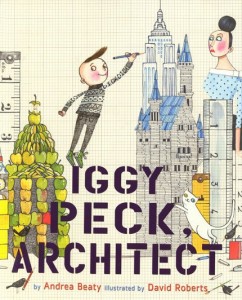I have the best of reasons for posting late this week: I’ve been on Mackinac Island at the Michigan Reading Association conference, being inspired by dedicated educators and loving the slower pace of an island with no automobiles. Now I’m sitting in a white wicker rocking chair with a cup of coffee and my laptop, dear husband at my side, watching sailboats glide by. The only thing that could make this any better would be a great book, and luckily, I have one.
Rosie Revere, Engineer written by the marvelously talented Andrea Beaty and illustrated by David Roberts is one of the rare rhyming book gems: the story is as solid as the meter and the language isn’t dumbed down in order to make a rhyme. Rosie Revere is the kind of girl most creative people will relate to: joyfully inventive, but so fearful of failure and ridicule that she hides her inventions away. The “gadgets and gizmos” she creates are fantastic, and I love Roberts’ whimsical and yet credible drawings of them. (I myself would love a pair of Rosie’s helium pants.) Rosie’s desire to help her great-great-aunt Rose fulfill her lifelong dream of flying gives Rosie the courage to test one of her inventions.
“The heli-o-cheese-copter sputtered and twitched.
It floated a moment and whirled round and round,
then froze for a heartbeat and crashed to the ground.”
Rosie is devastated by the failure, and by her great-great-aunt’s laughter, until she hears,
“‘Your brilliant first flop was a raging success!
Come on, let’s get busy and on to the next!’“
So not only is the message of this book one that every creative person with perfectionist tendencies needs to hear (I’m keeping it by my bedside table as a reminder) but it has historical notes in it about Amelia Earhart and E. Lillian Todd (the first woman to design airplanes) and Rosie the Riveter and other strong women whose names and deeds should be known. For a social studies lesson, you could easily springboard from this book into studying awesome women inventors. For math-science-art, get graph paper and a bunch of doodads and thing-a-ma-bobs for students to plan, design, build, test, and refine their own inventions. If you ask people to donate old, broken electronic gadgets to your class and bring in small tools, your students can take apart old radios and remote controls to disassemble and use. Build those Phonological Awareness skills by focusing on the rhyme, then discuss the interesting word choices for a Craft & Structure lesson. To keep rocking those Core Standards in Reading, you can easily work in Integrating Knowledge & Ideas by comparing Rosie Revere, Engineer to Iggy Peck, Architect by the same power duo.
So share this book with absolutely everyone you know, and get busy taking creative risks, because
“Life might have its failures, but this was not it.
The only true failure can come if you quit.”
For more information on the author, please visit andreabeaty.com.
For more information on the illustrator, please visit davidrobertsillustration.com.




